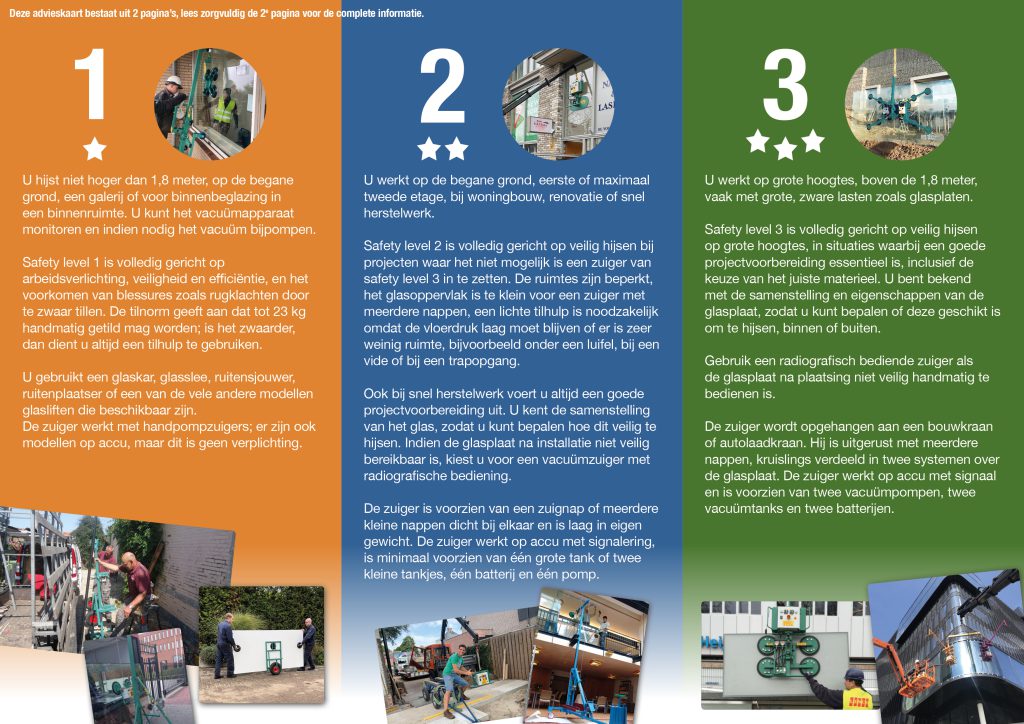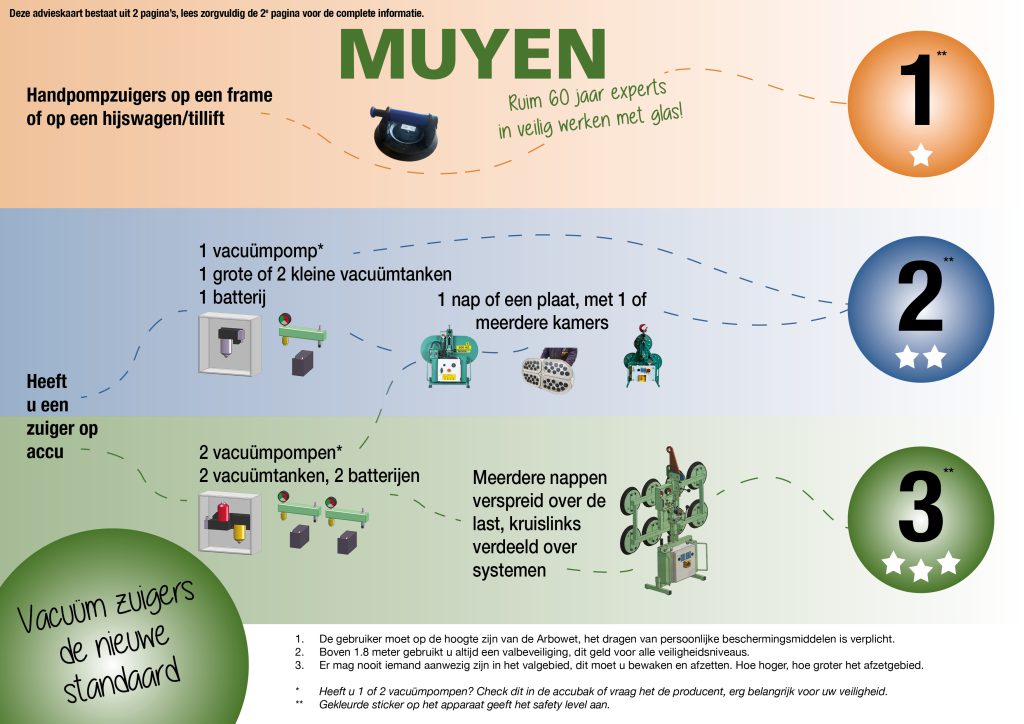Vacuüm zuigers de nieuwe standaard
Service afspraak makenEr zijn 3 belangrijke punten die u moet weten over de veiligheid en het gebruik van vacuümheffers op de bouwplaats.
- Iedereen in Europa praat over het dubbele circuit bij vacuümheffers, maar als je hier eerlijk naar kijkt, is dit een schijn veiligheid. Glas breekt of glijdt van een vacuümheffer en een dubbel circuit helpt niet. Het enige wat kan helpen is valbeveiliging in de vorm van banden rond het glas. Ook bij een ongeval zal een rechter aangeven dat u een val beveiliging had moeten gebruiken. Een vacuümheffer maakt geen vaste verbinding met de last, daarom maak je gebruik van een 2e positief veiligheidssysteem. Dit is erg belangrijk om als gebruiker te weten. Wij herinneren onze klanten er daarom aan om altijd valbeveiliging te gebruiken, vooral bij het tillen op grotere hoogte of afstanden met een vacuümheffer. Het gebruik van een dubbel vacuümsysteem ontslaat u niet van deze verplichting.
- Uiteraard weten wij ook dat valbeveiliging, spanbanden om het glas, onhandig is en vaak niet wordt gebruikt, ondanks dat dit een verplichting is. Daarom kiezen veel veiligheidsexperts ervoor om op de bouwplaats een dubbel systeem te eisen, onder het mom van: “Baat het niet, dan schaadt het niet” en dat is heel begrijpelijk. Het woord dubbele beveiliging klinkt simpelweg veiliger, maar is het helaas niet.
- Omdat de Europese norm de bouwwijze van een dubbel vacuümcircuit niet precies omschrijft zijn er veel vacuümheffers op de markt gekomen met een dubbel circuit, maar deze hebben 2 grote constructiefouten:
A: Deze machines zijn voorzien van slechts een kleine zuignap, terwijl de zuignappen over de last, oftewel glasplaat, verdeeld moeten worden en kruislinks over beide circuits moeten worden aangesloten.
B: Deze machines zijn gebouwd met 1 vacuümpomp, terwijl je bij een dubbel systeem mag verwachten dat deze is uitgerust met 2 pompen, 2 tanks en 2 accu’s.
Om onze gebruikers, maar ook veiligheidsinspecteurs, te voorzien van de juiste informatie over de veiligheid van vacuümheffers, hebben wij in samenwerking met Notified Body TUV, de Arbeidsinspectie, en werkgevers- en werknemersorganisaties, het 1, 2 3* veiligheidssysteem voor vacuümheffers ontwikkeld.
Vanaf december 2023 zijn alle vacuümheffers voorzien van een herkenbare sterklasse sticker met OR-code met duidelijke informatie over waar het apparaat gebruikt mag worden.
Het werkt heel eenvoudig:
1* Gebruik van een handpomp of pompzuigers, handmatig of op batterijen, voor gebruik op de begane grond onder de 1,8 meter. Liften of transportwagens die het handmatig tillen voorkomen, waardoor rugklachten worden voorkomen en veilig werken wordt bevorderd.
2* Deze vacuümheffers werken altijd op accu. Als een 3* klasse vacuümheffer te groot of te zwaar is, kies je voor een 2* machine. Denk hierbij aan renovatieprojecten waarbij de ruimte vaak klein is, de vloerbelasting laag moet zijn of het glas simpelweg te klein is voor een grotere spinvacuümheffer. Tot deze 2* klasse lifters behoren ook alle 1-pad vacuümheffers of vacuümheffers met een dubbel systeem, maar met slechts 1 vacuümpomp.
3* Dit is de hoogste en veiligste klasse. De vacuümheffer is altijd een spinmodelheffer waarbij de nappen verdeeld zijn over de last en kruislings verbonden zijn tussen de 2 systemen. De vacuümheffer is voorzien van een dubbel vacuümsysteem met 2 pompen, 2 tanken en 2 batterijen.
Zoals eerder aangegeven is in klasse 2 en 3 bij tillen boven de 1,8 meter valbeveiliging in de vorm van spanbanden rond de glasplaat verplicht.
There are 3 important points you need to know about safety and use of vacuum lifters on the construction site.
- Everyone in Europe talks about the double circuit on vacuum lifters, but if you look at this honestly, this is a false sense of security. Glass breaks or slips from a vacuum lifter and a double circuit does not help. The only thing that can help is fall protection in the form of bands around the glass. A judge will also assess this in the event of an accident. A vacuum lifter does not make a permanent connection to the load, so you use a 2nd positive safety system. This is very important to know as a user. We therefore remind our customers to always use fall protection, especially when lifting at greater heights or distances with a vacuumlifter. The use of a double vacuum system does not release you from this obligation.
- Of course we also know that fall protection, straps around the glass, is inconvenient and is often not used, despite the fact that this is an obligation. That is why many safety experts choose to require a double system on the construction or building site, under the guise of: if it doesn’t help, it won’t hurt and that is very understandable. The word double security simply sounds safer.
- Because the European standard does not precisely explain the construction of a double vacuum circuit, many vacuum lifters have come onto the market with a double circuit, but they have 2 major construction errors: A: These machines are equipped with only a small suction pad, while the suction pads should be spread over the load, or glass plate, and connected cross-linked over both circuit. B: These machines are built with 1 vacuum pump while you should expect a dual system to be equipped with 2 pumps, 2 tanks and 2 batteries.
- In order to provide our users, but also safety inspectors, with the correct information about the safety of vacuum lifters, we developed the 1, 2 3 * safety system for vacuum lifters on side, in collaboration with Notified Body TUV, the Labor Inspectorate, employers and employee organizations.
From December 2023, all vacuum lifters will be provided with a recognizable star class sticker with OR code with clear information about where the device may be used.
it’s simple:
1* Use of hand pump or manual vacuüm lifters, manual or battery powered, for use on the ground floor below 1.8 meters. Lifts or transport dolly’s that prevent the labor of manual lifting, thereby preventing back problems and promoting safe working.
2* These vacuum lifters work on battery always. If a 3* class vacuum lifter is too large or too heavy you choose a 2* machine. Think about renovation projects where space is often small, floor loads must be low or simply the glass is too small for a larger spider vacuumlifter. This 2* class lifters also includes all 1 pad vacuum lifters or vacuum lifters with a double system, but with ony 1 vacuum pump.
3* This is the highest and safest class. The vacuum lifter is always a spin model lifter with the cups distributed over the load and cross-linked between the 2 systems. The vacuum lifter is equipped with a double vacuum system with 2 pumps, 2 tanks and 2 batteries.
As indicated earlier, in class 2 and 3, when lifting above 1.8 meters, fall protection in the form of straps around the glass plate is mandatory.



